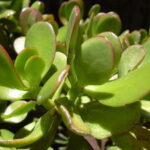Jade, also known as Crassula argenea is another easy to care for houseplant. This plant with its fleshy leaves and trunk-like stems prefers to be ignored, the less attention it gets the better. Just place it where it can get about 4 hours of sunlight and forget it. Watering and repotting are two factors that do not play a big part in the life of this plant. It requires very little water and is very slow growing. So, if you are looking for a beautiful plant that requires very little care, this is a perfect plant for you.
As with any other plant, this plant does have a few requirements to remain healthy and beautiful. These are sunlight, water, temperature, soil type and the care it receives.
The amount of sunlight the Jade plant requires is generally about 4 hours of direct sunlight, but it will also thrive in bright, indirect sunlight. Direct sunlight will also cause a change in the color of the leaves of this plant; they will have a red border on them.
Water, the next important factor when caring for these plants, needs to be regulated very closely, as too much water will cause great problems with the plant. Watering should be done when the leaves feel squishy to the touch, which will occur about once a month in the summer and even less during the winter. The soil should be allowed to completely dry before watering. The correct method of watering when it is time, is to saturate the soil completely, then allow the soil to dry out. Over watering can prove to be deadly to a Jade plant. This condition will cause root rot, which usually cannot be corrected. The best thing to do when root rot is found is to take cuttings and propagate the plant.
Jade plants are tolerant of a wide range of temperatures, but actually do best in moderate temperatures. If the temperature falls below 55 degrees, the plant will become dormant and the amount of light should be reduced.
Soil type is another factor to consider for this plant. Being a succulent, the type of soil is very important. Sandy or coarse soil is best, as it will allow draining. If mixing your own soil, use four parts loam plus one part sand and one part broken brick. Repotting is also important, but not until the plant has become rootbound. Repot with a pot just one size larger than the pot the plant is in along with the soil recommended and your plant will remain happy and healthy.
Propagating a Jade plant is also as easy as caring for one. To propagate several methods can be used. These are seeds, leaf cuttings or stem cuttings. The most effective is stem cuttings. Cut stems 3″ in length, and then allowed the cutting to dry for several hours or even overnight. A protective coating will cover the cut after it has been allowed to dry. After allowing to dry and the protective coating has been seen, remove the bottom leaves off the cutting and place it into soil. Allow the soil to completely dry out before watering, usually in a week or so. After awhile, you will have another beautiful Jade plant to enjoy in your home.
Jade plants have other interesting facts such as being able to live outdoors in summer and their connection to Feng Shui. Jade plants can also be used outdoors in summer, as are other houseplants, but they should be brought in before the temperatures begin to get too cold. People who practice Feng Shui also are fond of Jade plants and consider them to be plants that will bring money into their life because of their coin-like leaves. The main thing to remember about a Jade plant is that it is one of the easiest houseplants to care for and enjoy.





